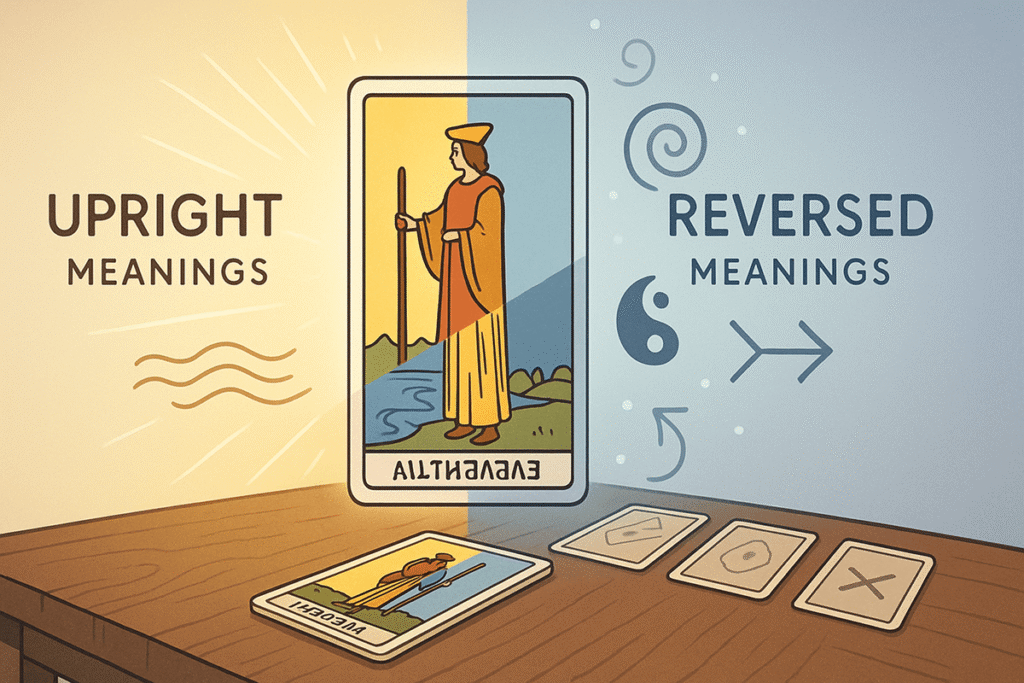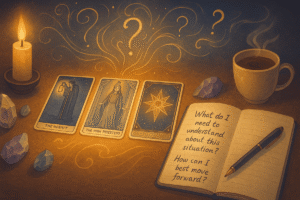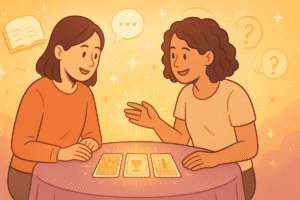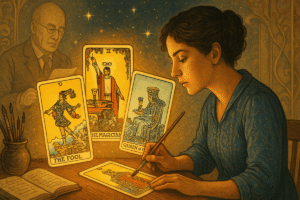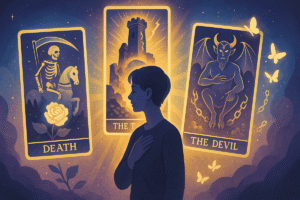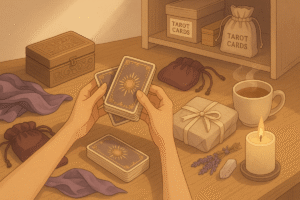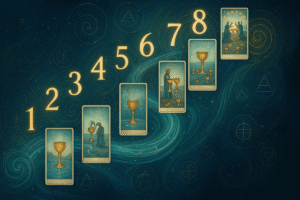Table of Contents
When I first encountered a reversed tarot card in my reading, I’ll admit I felt a moment of panic. The card looked upside down, and I wondered if this was somehow “wrong” or if it carried negative meaning. Perhaps you’ve experienced something similar? That initial confusion is completely natural, and I’ve come to realize that reversed cards offer some of the most profound opportunities for self reflection in tarot practice.
Reading reversed tarot cards doesn’t have to feel intimidating. Think of them as another layer of conversation with yourself, another angle from which to explore your inner landscape. Some readers choose to work with reversals from day one, while others prefer to master upright meanings first. There’s no universal rule here, and your approach can evolve as your comfort with the cards grows.
Understanding What Reversed Cards Represent
A reversed tarot card appears when a card is drawn upside down from its traditional orientation. But what might this positioning invite you to consider? Different readers and traditions offer various perspectives, and you might find that different approaches resonate with you at different times.
The most common interpretation suggests that reversed cards represent blocked or delayed energy. When The Sun appears reversed, for instance, you might ask yourself what’s preventing joy from flowing freely in your life right now. What obstacles, internal or external, seem to be casting shadows on your natural optimism? This isn’t about predicting doom, but rather about identifying areas where energy might be stuck.
Another approach views reversals as energy turning inward. A reversed Strength card might prompt you to reflect on how you’re cultivating inner courage rather than displaying it outwardly. Sometimes we need to build our foundation privately before we can share our power with the world. This internal focus can be just as valuable as external action.
Some readers interpret reversals as the opposite or shadow aspect of the upright meaning. However, I’ve found this approach requires careful consideration. Rather than seeing reversals as purely negative, they often reveal the full spectrum of a card’s energy. The reversed Hermit might not indicate loneliness, but rather the need to balance solitude with connection.
Approaches to Reading Reversed Tarot Cards
When you encounter a reversed card, you might experiment with asking different types of questions. What internal work needs attention in this area of your life? Where might you be rushing when patience would serve you better? How could you approach this situation from a different angle?
I sometimes think of reversed cards as gentle nudges to pause and reconsider. They invite us to look beneath the surface or examine our assumptions. If you draw a reversed Two of Cups, you might reflect on how you’re relating to others. Are you truly connecting, or are there barriers you haven’t acknowledged?
The blocked energy interpretation can be particularly useful for personal growth. When energy feels stuck, reversed cards might encourage you to explore what’s creating that blockage. Is it fear? Old patterns? External circumstances? This self inquiry can reveal insights that help you move forward with greater awareness.
The inward energy approach offers another rich avenue for exploration. Sometimes reversed cards suggest that the energy of that card needs to be cultivated internally before it can manifest externally. A reversed Ace of Wands might prompt you to nurture creative sparks privately before sharing them with the world.
Choosing Your Own Path with Reversals
Here’s something I wish someone had told me when I started: you don’t have to read reversals if you don’t want to. Some experienced readers never use them, preferring to work exclusively with upright cards. Others incorporate reversals from their very first reading. Both approaches are completely valid.
If you’re feeling overwhelmed by the idea of doubled meanings for each card, consider starting with upright readings only. You can always introduce reversals later when you feel more confident with the basic card meanings. There’s wisdom in building a strong foundation before adding complexity.
When you do feel ready to explore reversals, you might start with just one or two cards in a reading. Notice how the reversed position changes your reflection on that card’s message. Does it feel different? Does it prompt different questions?
Some readers establish a personal rule about when to read reversals and when to turn cards upright. You might choose to read all cards as they fall, or you might decide that only significantly reversed cards (clearly upside down) count as reversals. Trust your intuition about what feels right for your practice.
Practical Tips for Working with Reversed Cards
When you encounter a reversed card, take a moment before diving into interpretation. How does the image look upside down? Sometimes this visual shift alone can spark insights. The figures in the card might appear to be falling, reaching downward, or moving in an unexpected direction.
Consider keeping a journal specifically for reversed card experiences. What patterns do you notice? Do certain cards frequently appear reversed for you? What themes emerge in your reflections? This documentation can reveal valuable insights about your personal relationship with reversed energy.
I’ve found it helpful to approach reversed cards with curiosity rather than concern. Instead of asking “What’s wrong?” try asking “What’s asking for attention?” This subtle shift in questioning can lead to more constructive self reflection.
If a reversed card feels confusing, you might draw a clarifying card to explore the message further. Sometimes the combination of cards reveals nuances that a single reversed card alone might not communicate clearly.
Common Misconceptions About Reversed Cards
One persistent myth suggests that reversed cards are inherently negative or indicate bad luck. This perspective can create unnecessary anxiety and limit the depth of your self reflection. Reversed cards are simply another way energy might be expressed or experienced.
Another misconception is that every reversed card must be interpreted as a reversal. Some readers prefer to view all cards through their upright meanings, regardless of orientation. This approach emphasizes the full spectrum of each card’s energy rather than creating separate categories.
I’ve also encountered the belief that reversed cards are more difficult to read than upright cards. While they do add another layer of consideration, this complexity can actually enrich your reflective practice. The additional nuance might reveal insights that wouldn’t emerge from upright readings alone.
Perhaps most importantly, there’s no single “correct” way to read reversed cards. Different readers, different traditions, and different moments might call for different approaches. Your interpretation method can evolve as your understanding deepens.
Building Confidence with Reversed Readings
Start small when incorporating reversals into your practice. You might begin by noting when cards appear reversed but reading them upright until you feel ready to explore the reversed meanings. This gentle approach allows you to observe patterns without feeling pressured to interpret every reversal immediately.
Consider practicing with cards you know well first. If you’re comfortable with The Fool upright, exploring The Fool reversed might feel less daunting than starting with a complex court card. Build your confidence with familiar energy before venturing into less familiar territory.
Remember that your first interpretation doesn’t have to be your final interpretation. Reversed cards, like upright cards, might reveal different meanings as you sit with them over time. What seems unclear initially might become more apparent after reflection or as situations in your life evolve.
Most importantly, trust your intuitive responses to reversed cards. Your immediate reaction to seeing a card upside down contains valuable information. That moment of recognition or confusion is data worth exploring, even if you can’t immediately articulate what it means.
Integrating Reversals into Your Personal Practice
The beauty of tarot lies in its ability to adapt to your unique needs and perspectives. Some days you might feel drawn to work with reversals, while other days you might prefer the clarity of upright readings. Both inclinations are worth honoring.
As you develop your own relationship with reversed cards, you might discover personal associations that differ from traditional interpretations. Perhaps a certain reversed card consistently prompts you to consider a specific theme or question. These personal meanings are just as valid as conventional interpretations.
Consider how reversed cards fit into your overall approach to self reflection and personal growth. Do they encourage you to slow down? Look inward? Question assumptions? Understanding their role in your practice can help you use them more intentionally.
Reading reversed tarot cards is ultimately about expanding your toolkit for self exploration. They offer additional perspectives on familiar themes and can deepen your understanding of the cards’ multifaceted nature. Whether you choose to work with them regularly or occasionally, reversals provide another pathway for meaningful reflection and personal insight.
The most important element in reading reversed cards is maintaining that spirit of curious inquiry that makes tarot such a valuable tool for self reflection. Approach them with the same openness you bring to upright cards, and allow your understanding to develop naturally over time.
Frequently Asked Questions
Are reversed tarot cards always negative or bad?
No, reversed cards are not inherently negative. While some interpretations might point to challenges or blocks, reversals often reveal opportunities for growth, internal work, or simply a different expression of the card’s energy. A reversed card might indicate healing in progress, energy turning inward for development, or a necessary pause rather than something bad happening.
Do I have to memorize 156 card meanings if I use reversals?
Not at all. You don’t need to learn completely separate meanings for each reversed card. Instead, you learn a few interpretation methods like blocked energy, internal focus, or too much or too little of the card’s energy, then apply these approaches to the upright meanings you already know. This makes working with reversals much more manageable than memorizing entirely new definitions.
Can I just ignore reversed cards and turn them upright?
Absolutely. Many experienced readers never use reversals and have rich, insightful practices. Some readers find reversals add helpful nuance, while others feel they interrupt the flow of their readings. There’s no requirement to read reversals, and choosing not to use them doesn’t make you any less skilled as a reader.
How do I know which interpretation method to use for a specific reversed card?
This comes down to context, intuition, and the surrounding cards in your reading. Notice how you feel when you first see the reversed card. Consider the question you asked and what would make sense for your situation. Sometimes the blocked energy interpretation feels right, other times the internal focus makes more sense. With practice, you’ll develop a sense of which approach fits each moment.

